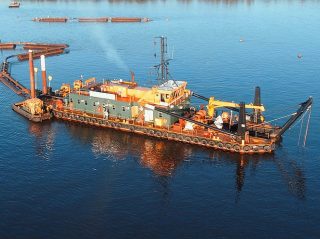


A contractor for the U.S. Army Corps of Engineers is set to begin dredging Jekyll Creek north of Downing Musgrove Causeway to the St. Simons Sound on April 10, informs the Georgia Department of Natural Resources.
Cottrell Contracting, of Chesapeake, Va., will remove about 200,000 cubic yards of sediment from the eastern 75 feet of the channel, which is part of the Atlantic Intracoastal Waterway.
USACE and other groups have had long-standing navigational concerns over the Jekyll Creek portion of the Atlantic Intracoastal Waterway.
It is the shallowest point in more than 160 miles of Georgia’s portion of the waterway. Jekyll Creek has not been dredged since 1998, and its sediments are fine-grain with very low sand content, often called “pluff mud.”
This $6 million, federally funded project will bring the channel’s depth to 10 feet and is expected to be complete April 27 May 15 (date revised March 11, 2019). The removed sediment will be placed in two locations using new methods meant to keep Georgia’s sediments in the coastal system and help keep marshes healthy.
The first sediment-placement location is north of Jekyll Creek in the St. Simons Sound, about 800 feet south of the St. Simons Pier. This location, commonly called the “Deep Hole” will receive about 97 percent of the dredged sediment, removed during the Jekyll Creek works.
The remaining dredge sediments will be placed on nearby marsh using a spray technique known as “rainbowing.” About 5,000 cubic yards of sediment is scheduled to be pumped onto the marsh north of the Jekyll Island Airport.
These techniques are part of a “beneficial use of sediments” pilot project and have never been performed in Georgia. The primary goal of the project partners is to proactively explore whether these techniques can be used in the future to build a more resilient Georgia coast.